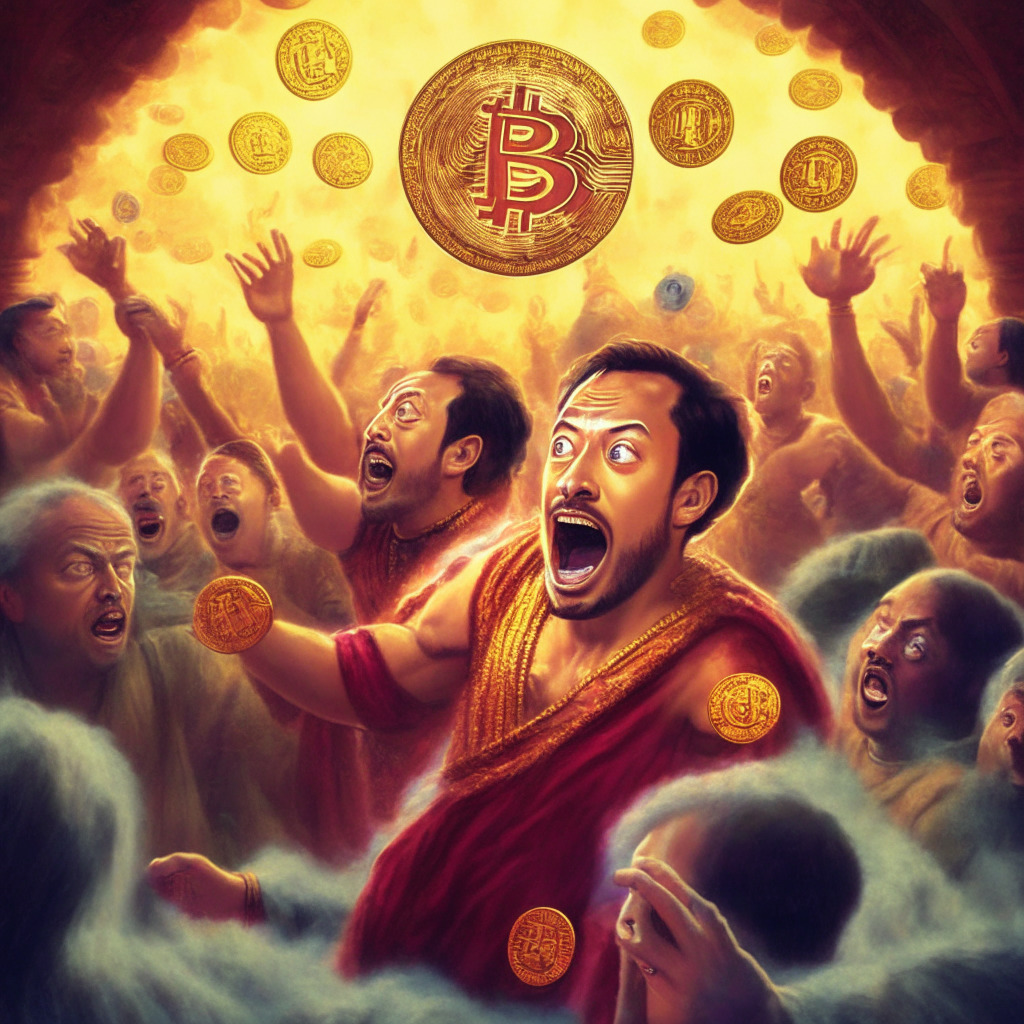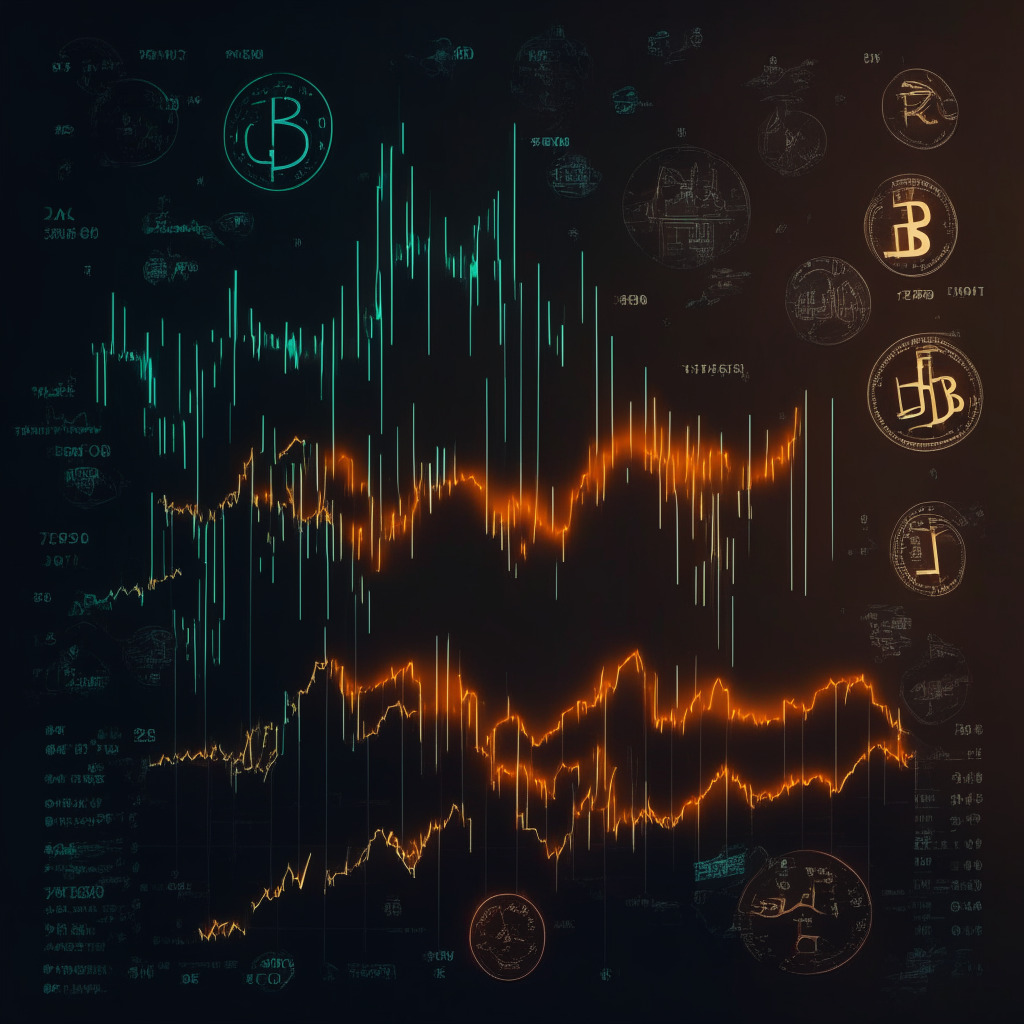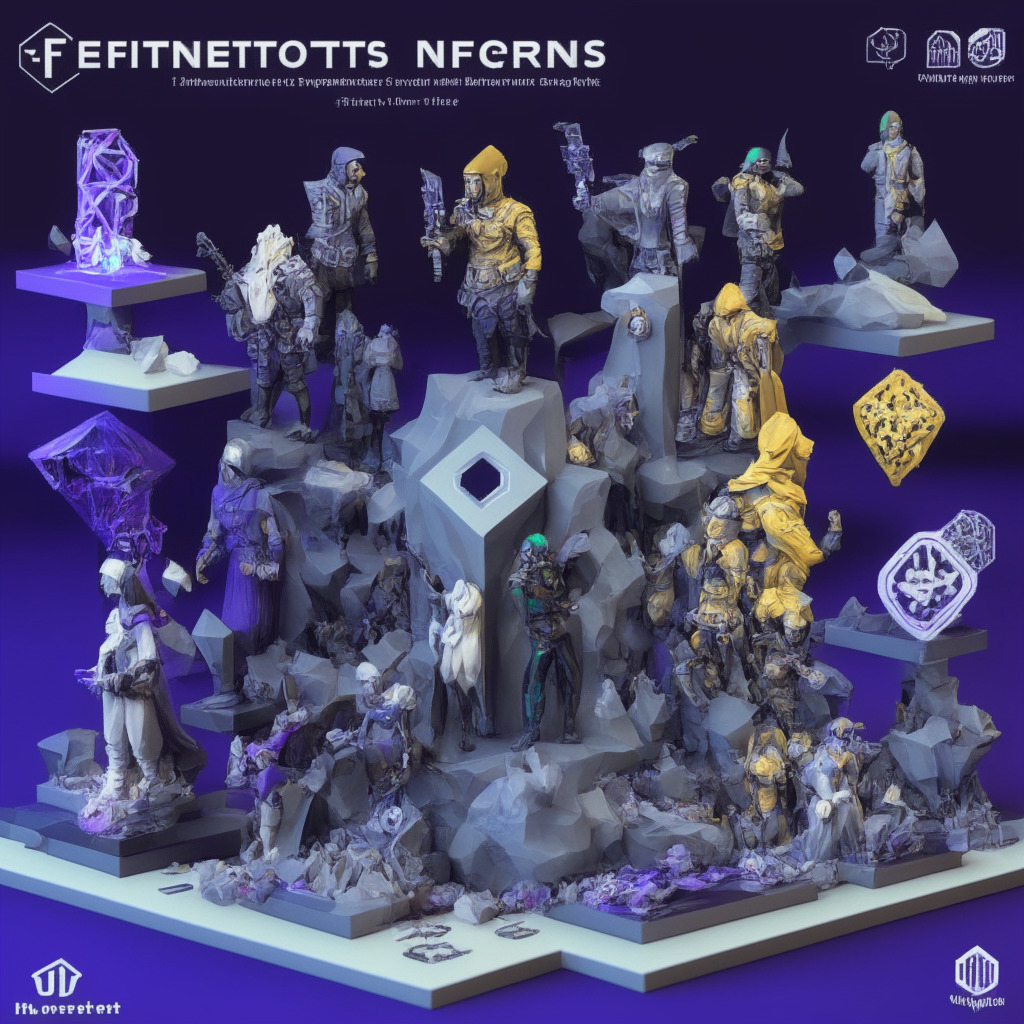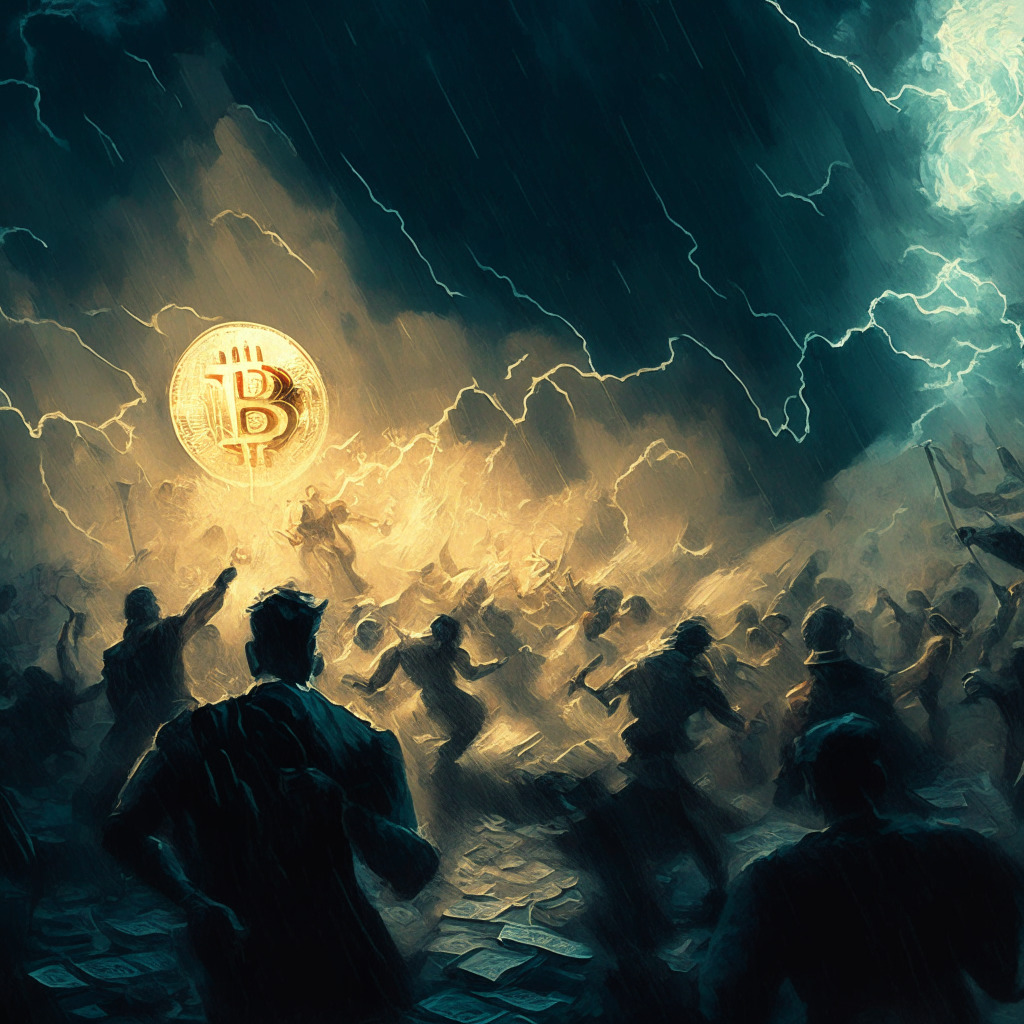The DOGE price might see a bullish upswing in the upcoming week with several lower price rejections at the support level of $0.071. Technical indicators, such as the 4-hour Relative Strength Index, suggest potential bullish movement, raising the possibility of an upswing towards the overhead trendline.
Search Results for: RSI
Lawsuit Accuses Jump Trading of Manipulating TerraUSD: Market Deception & Regulatory Pressure
A lawsuit against Chicago-based Jump Trading accuses the firm of conspiring with Terraform Lab’s then-CEO to manipulate TerraUSD (UST) stablecoin’s value, misleading investors about its price and risks. The suit highlights the need for clearer regulations, increased oversight, and investor awareness about potential risks in the crypto sector.
XRP’s Ascending Triangle Pattern: A Glimmer of Hope or Prolonged Correction?
XRP has been trading sideways, consolidating between $0.433 and $0.408, showcasing uncertainty surrounding the coin. However, examining the shorter time frame chart reveals the formation of a bullish ascending triangle pattern, signaling a potential upswing. The rising support trendline is expected to push the price higher, potentially clearing the neckline resistance of $0.44.
Ethereum Price Battle at $1827: Bearish Dive or Bullish Rebound Imminent?
The Ethereum market recently experienced a price breakdown from $1827, signaling a potential extended correction. However, buyers remain active near the 100-day EMA at $1766. Traders should watch for competition between buyers and sellers to determine the coin’s upcoming trend. Bearish momentum could weaken if the buying pressure continues, but a longer correction towards $1600 is also possible.
Twitter 2.0: Dogecoin’s Role and the Future of Crypto under Linda Yaccarino’s Leadership
Linda Yaccarino takes over as Twitter CEO under Elon Musk’s influence, with a possible integration of payment services featuring Dogecoin and cryptocurrencies. The future remains uncertain as market conditions and Yaccarino’s leadership could impact adoption and recognition of digital currencies.
Bitcoin’s $27,000 Support Defense: Bullish Reversal or Temporary Hold? Pros, Cons & Main Conflict
Bitcoin price showed a breakdown attempt from the monthly support of $27,000-$26,786 on May 12th, but buyers defended the support, suggesting a possible bullish reversal. The current correction phase is governed by a resistance trendline, with Bitcoin trading at $26,874 and an intraday loss of 0.12%. A breakout could signify uptrend resumption and re-challenge the $31,000 peak.
Pepecoin’s Bullish Reversal: Analyzing the Inverted Head & Shoulder Pattern and Potential Gains
The recent correction in Pepecoin price showcased a bullish reversal, with the market value nearly doubling in two days. The 4-hour chart exhibits a bullish reversal pattern, indicating a potential rally. With sustained buying, the coin price could increase by 8-10%, while a breakout from the trendline could surge the price by an additional 50%. Technical indicators favor a bullish forecast.
QuadrigaCX Collapse: Creditors to Receive Only 13% of Claims, Raising Crypto Market Concerns
Former QuadrigaCX users will receive only 13% of their total claims as accounting giant Ernst & Young published a notice regarding the 13.094156% payout to each creditor. QuadrigaCX owes CAD $303.1 million across 17,648 claims, including Canada Post and Canada Revenue Agency. The exchange’s collapse in 2019 highlights the need for proper oversight and regulation in the crypto market.
Ethereum’s Beacon Chain Finality Issues: Lessons Learned & Network Resilience
Ethereum core developers quickly addressed Beacon Chain finality issues by rolling out patches for Prysm Labs and Teku clients. High load on Consensus Layer clients caused the problem which affected transaction finalization. Upgrades released by Teku and Prysm help prevent excessive resource usage and mitigate future issues. Continuous improvement and diverse ecosystem of clients are crucial for blockchain technology’s resilience.
Crypto Market Plummets: Analyzing BTC and ETH Losses amid Dollar Surge and NFT Downtrend
Bitcoin (BTC) and Ethereum (ETH) experienced moderate losses as the weekend approached, despite a slight surge earlier in the week. Rising dollar value, NFT trading volume drop, and high transaction fees contributed to the decline. Meanwhile, American crypto exchange Bittrex filed for bankruptcy amid regulatory struggles.
Florida Bans CBDCs: A Stand for Privacy and Financial Independence or Hindrance to Progress?
Florida Governor Ron DeSantis signed a bill prohibiting central bank digital currencies (CBDCs) in Florida, citing concerns about privacy, financial independence, and potential misuse for control and surveillance. The decision highlights essential questions about digital currencies and their impact on individual freedom and autonomy.
Meme Coin Shift: Exploring Early Investment Strategies in SPONGE as FLOKI Faces Resistance
This update explores the latest trends in the meme coin market, focusing on Floki Inu and the rising interest in low market cap meme coin SPONGE. As the popularity of meme coins grows, investors are seeking early-stage investment opportunities in cryptocurrencies like SPONGE for potential gains.
Terra Classic Upgrade Debate: Skepticism Meets Optimism in Blockchain’s Future
Terra Classic’s Proposal for v2.0.1 Upgrade has crossed the threshold limit, marking a significant LUNC blockchain upgrade. With 99.5% of votes in favor, it introduces critical features, including minimum initial deposit for governance proposals, Cosmos SDK and Tendermint updates, and improvements to code maintainability. However, former core developer Tobias “Zaradar” Anderson remains skeptical about the upgrade’s success.
Meme Coins Surge on Indian Crypto Exchange: Growing Trend or Passing Fad?
India’s top cryptocurrency exchange, Unocoin, recently listed meme coins FLOKI and PEPE, offering users more diverse investment options. However, the long-term sustainability of meme coins remains questionable, as their popularity relies heavily on social media hype, possibly creating a bubble that could burst and impact smaller investors.
Entering the Abstraction Era: How Blockchain Becomes an Invisible Infrastructure
The Abstraction Era of blockchain will see users transact with fiat, while the conversion to tokens occurs behind the scenes. This era mirrors the cloud computing revolution, streamlining user experiences without requiring understanding of the underlying technology.
Bitcoin
Bitcoin’s trajectory is a topic of debate among investors and experts. Global Macro Director of Fidelity Investments, Jurrien Timmer, highlights Bitcoin’s role as a powerful inflation hedge, while MicroStrategy’s Michael Saylor emphasizes its importance in a declining fiat currency landscape. However, declining liquidity on Binance and other market factors contribute to potential volatility.
Ethereum Clients Prysm & Teku Fix Finality Issues: Analyzing Pros, Cons & Network Resilience
Ethereum consensus clients Prysm and Teku have released updates to address Beacon Chain finality issues. Although these issues did not impact end users and transactions, they raised concerns for stakers and developers. Client diversity remains crucial in maintaining network resilience during partial failures.
Bank Deposits Decline: Crypto’s Surge or Inflation’s Crippling Effects?
US bank deposits are nearing $17 trillion, possibly signaling a shift towards cryptocurrencies like Bitcoin. Factors like bank failures, inflation concerns, and increased interest rates contribute to this decline, driving investors to explore alternative investment opportunities such as crypto. However, caution and thorough research are necessary before committing to cryptocurrency investments.
yPredict Presale: AI-Powered Trading, Market Insights & Potential 70% Returns for Investors
yPredict’s presale is gaining interest among crypto enthusiasts due to its AI-powered trading and market intelligence approach. The project offers strong fundamentals and potential for lucrative returns, while minimizing rug pull risks with a solid tokenomics structure.
RAC’s CULT Pass: Merging Web3, AI & NFTs to Connect Artists and Audiences
RAC has collaborated with HIFI Labs to launch the CULT Pass, a dynamic NFT membership pass with visuals by artist Andres Reisinger and audio by RAC. This innovative project combines Web3 and AI to explore the possibilities of building a deeper connection between artists and audiences, providing ownership of the community and creating immersive membership experiences.
Google Bard vs. OpenAI ChatGPT: The Battle for AI Chatbot Dominance and Future Implications
Google’s AI chatbot, Bard, challenges OpenAI’s ChatGPT with upgrades introduced at the Google I/O conference. Transitioning to the PaLM 2 model and offering different versions for various applications, Bard provides improved performance in translation and coding support. Despite ChatGPT’s current adoption advantage, Bard’s free availability may attract users.
Crypto Market Dips: Opportunity or Warning? Uncovering Top Picks Among AI, XLM, ATOM & More
Bitcoin has fallen below $27,000, causing concern for the crypto market’s immediate future. However, some investors are eyeing a potential dip to buy. Despite recent developments, AI, BGB, SPONGE, XLM, YPRED, ATOM, and DLANCE remain strong investment opportunities with solid fundamentals and technical analysis.
El Salvador’s Bitcoin Boom: Surf Haven or Smoke and Mirrors? Pros, Cons, and Main Conflict
El Salvador’s adoption of Bitcoin and focus on surf tourism has attracted a record one million tourists, despite concerns about government transparency and crime-fighting strategies. As the country strives to become a tech hub, ensuring transparency and addressing criticisms is essential for continued success in cryptocurrency and tourism.
Ubisoft’s Assassin’s Creed NFTs: Innovation or Over-Valuation Risk? Pros and Cons
Ubisoft collaborates with Integral Reality Labs to create Assassin’s Creed Smart Collectibles – NFT access passes on Polygon network with redeemable 3D-printed keepsakes. This partnership highlights the potential of incorporating NFTs in gaming while addressing concerns of a speculative market bubble.
Lido’s v2 Upgrade: A Step Towards Decentralization or Risky Gamble for Ethereum Staking?
Lido is currently voting on its second iteration, v2, on the Ethereum blockchain. The upgrade aims to introduce ETH staking withdrawals and a “Staking Router” for diverse node operator participation, potentially increasing decentralization and expanding Ethereum’s staking ecosystem.
Major Questions Doctrine: Friend or Foe in Crypto Regulation Battle?
The major questions doctrine, a legal principle in U.S. administrative law, could potentially diminish the SEC’s authority in regulating the cryptocurrency industry. Kraken’s Chief Legal Officer, Marco Santori, believes this concept is relevant as lawmakers deliberate on cryptocurrency regulations and should be considered by the SEC and CFTC.
US
The US is considering adopting Europe’s cryptocurrency regulation model, MiCA, for increased transparency, security, and consumer protection. However, concerns about privacy, personal freedom, and stifling innovation must be balanced in this evolving regulatory landscape.
LG’s Blockchain-Based Smart TV: Revolutionizing NFT Trading or Exposing Users to Risks?
LG Electronics filed a patent application for its blockchain-based Smart TV, enabling users to trade NFTs by connecting to a crypto wallet and NFT market server. The move follows the launch of LG’s NFT platform, the LG Art Lab Marketplace, highlighting its commitment to integrating Web3 solutions into its products while raising concerns about consumer safety and wallet integration restrictions.
Bipartisan Rift Emerges on Stablecoin Bill: Consumer Protection vs State Regulation
House Democrats are considering a separate stablecoin bill, highlighting a rift with the parallel Republican effort. Addressing stablecoins is a key priority for US lawmakers overseeing crypto operations. The Democratic bill focuses on consumer protection, granting the Federal Reserve veto power over issuer registration, while the Republican version empowers states to regulate issuers.
Binance Exits Canadian Market: Analyzing Impacts and Regulatory Tensions
Binance is withdrawing from the Canadian market due to new stablecoin guidance and investor limits for crypto exchanges, joining other crypto businesses like OKX and dYdX. The exit raises concern over reduced competition and innovation in Canada, while highlighting the ongoing tension between regulators and cryptocurrency companies.
Florida’s CBDC Ban: Protecting Privacy or Stifling Innovation? The Great Divide Explained
Florida Governor Ron DeSantis recently signed a bill barring the use of centralized digital dollars, intensifying the state’s opposition to central bank digital currencies (CBDCs). The move reflects the ongoing debate between supporters of cryptocurrencies and proponents of CBDCs, with concerns about government control, privacy, and financial inclusion shaping the future of digital assets.
Bitcoin’s Future at $25,000: Factors Influencing Market Sentiment and Key Price Levels
As Bitcoin nears the $25,000 support level, its future trajectory is uncertain due to factors like increased regulatory scrutiny, concerns around the Grayscale GBTC Trust Fund, and the strong US dollar. Technical indicators suggest a potential bullish rebound if Bitcoin stays above $26,000, but challenges remain.






























